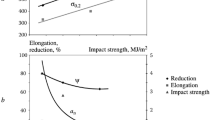Conclusions
The data presented indicate that steels intended for operation in media containing hydrogen sulfide should be alloyed with chromium, molybdenum, vanadium, niobium, aluminum, and copper.
The resistance to HE and HSC is highest for low-alloy steels with a fine-grained ferritic-pearlitic structure and alloy steels with a structure of temper sorbite.
Similar content being viewed by others
Literature Cited
V. I. Pasternak, Control of Hydrogen Sulfide Corrosion in Pipelines and Wells Abroad [in Russian], VNIIOÉNG, Moscow (1973), p. 53.
I. S. Shparber, Sulfide Cracking of Steel and Control in the Oil and Gas Refining Industry [in Russian], VNIIOÉNG, Moscow (1970).
C. Zapffe and S. Sims, Trans. AIME,149, 225 (1941).
H. Van Leuwen, Mem. Sci. Rev. Met.,71, No. 9, 509 (1974).
Ya. M. Potak, Brittle Fracture of Steel and Steel Parts [in Russian], Oborongiz, Moscow (1955), p. 389.
P. A. Rebinder et al., Indicators of Hardness in Drilling [in Russian], Izd. Akad. Nauk SSSR, Moscow (1954).
N. Petch, Phil. Mag.,1, No. 8, 331 (1956).
A. Troiano, TASM,52, 54 (1960).
P. Bastien and P. Amio, Fourth International Petroleum Congress [in Russian], Gostoptekhizdat, Moscow (1956), p. 124.
M. Smialowski, Hydrogen in Steel, Pergamon Press, London (1962).
E. Herzog, Rev. Met., No. 2, 123 (1958).
K. Farell and A. Quarell, J. Iron Steel Inst.,202, 1002 (1964).
J. Greer, E. Von Rosenberg, and J. Martinez, Corrosion,28, No. 10, 378 (1972).
P. Bastien, Arts et Manufactures,12, No. 5, 15 (1967).
W. Chandler and R. Wader, Hydrogen-environment embrittlement of metals and control. Hydrogen Energy, Part B. New York-London (1975), p. 1057.
G. M. Karpenko and R. I. Kripyakevich Effect of Hydrogen on Properties of Steel [in Russian], Metallurgizdat, Moscow (1962), p. 195.
V. Dal' et al., “Failure of steels under the influence of humid hydrogen sulfide”, Chernye Metally, No. 3, 3 (1967).
E. Miyoshe et al., ASME, No. 75, 2 (1975).
É. Lunarska, “Effect of plastic deformation on absorption of hydrogen by iron and steel”, in: Stress Corrosion and Hydrogen Embrittlement [in Russian], Dresden (1975), p. 48.
G. Shenk, E. Shmidtman, and G. F. Klerner, “Resistance of pipe steel with a minimum yield strength of 30 kgf/mm2 in solutions and gases containing hydrogen sulfide”, Chernye Metally, No. 3, 16 (1967).
K. Masamiti et al., “New steel for oil pipe with high resistance to corrosion cracking in sulfide environments”, Sumitomo Kindzoku,24, No. 3, 38 (1972).
E. Snape, Corrosion, NACE,23, No. 6, 154(1967).
D. R. Ramazashvili et al., “Pipe steels for gas wells in hydrogen sulfide fields,” in: Trans. Inst. Met. of the Academy of Sciences, Georgian SSR, Materials for New Technology [in Russian], Tbilisi (1971).
K. I. Vereshchagin, Yu. I. Rubenchik, and G. V. Karpenko, “Effect of alloying and microalloying on resistance of steels to cracking”, Fiz.-Khim. Mekh. Mater., No. 5, 15 (1971).
G. V. Karpenko et al., “Steels for pump-compressor pipe” Khim. Neftyanoe Mashinostr., No. 1, 23 (1973).
A. M. Zubko et al., “Effect of phosphorus and sulfur on hydrogenation of high-strength steel and its susceptibility to stress corrosion” Metalloved. Term. Obrab. Met., No. 12, 52 (1973).
E. Snape, Corrosion, NACE,24, No. 9, 261 (1968).
A. B. Kuslitskii, Nonmetallic Inclusions in Steel, [in Russian], Tekhnika, Kiev (1976),p. 124.
O. Kiku, J. Iron Steel Inst. Jpn.,61, No. 12, 774 (1975).
I. N. Grekov et al., “Means of increasing the resistance of steels in petrochemical apparatus”, Fiz.-Khim. Mekh. Mater.,5, 324 (1969).
V. P. Krylov, and I. I. Vorob'eva, “Hydrogen embrittlement of steel with nonmetallic inclusions”, Metalloved. Term. Obrab. Met., No. 5, 40 (1973).
G. M. Itskovich, “Formation of nonmetallic inclusions in steel deoxidized with aluminum and with calcium-containing alloys”, in: Steel and Nonmetallic Inclusions [in Russian], No. 1 Metallurgizdat, Moscow (1976), p. 134.
M. Tanimura et al., Tetsu-to-Hagane,62, No. 4, 347 (1976).
S. A. Golovanenko, I. Yu. Konnova, and T. K. Sergeeva, “Resistance to hydrogen embrittlement of steel 10Kh2GMA with aluminum”, Metalloved. Term. Obrab. Met., No. 8, 30(1976).
P. Grobner, D. Sponseller, and W. Gias, Mater. Perform.,14, No. 6, 35 (1975).
M. A. Krishtal, Mechanism of Diffusion in Iron Alloys [in Russian], Metallurgiya, Moscow (1972), p. 398.
M. Hill, E. Kawasaki, and H. Kronbach, “Metallurgical microstructure of casing pipe—evidence of susceptibility to rapid failure in a hydrogen sulfide environment,” in: Corrosion, Report No. 10, Houston (1971).
V. A. Kovalenko, “Effect of the structure of steel on hydrogen permeability”, Fiz.-Khim. Mekh. Mater.,9, No. 3, 115 (1973).
D. Stratmann and P. Grobner, Steels and Alloys with High Strength and Resistance in an Atmosphere of H2S for Pipe Used to Extract Oil [Russian translation], VTsP, Moscow, SR-772 (1976).
H. Russev, Rev. Met., No. 4, 371 (1967).
S. Asano et al., “Effect of pinning of hydrogen by dislocations on its diffusion in low-carbon steel”, Nikon Kindzoku Gakkaisi,38, No. 7, 626(1974).
E. Snape, F. Schaller, and R. Forbes-Jones, Corrosion,25, No. 9, 380 (1969).
M. Chaichois and M. Pailassa, Corros. Anticorros.13 No. 1, 37 (1965).
API Specification for Grade C-75-C-95 Casing and Tubing. Americal Petroleum Institute Publication, March, 1973.
T. Swanson and J. Fralmer, Materials Protection and Performance,11, No. 1, 36 (1972).
Sumitomo Metal Industries Ltd., Wakayama Steel Works, Technical Information (SM-85SS), April, 1975.
Materials Protection,5, 81. NACE Publication 1F, 166 (1966).
Creselso-38, TT st 36 (Dillinger). Stahl-Eisen-Werkstoffblat (089) (1970).
Additional information
I. P. Bardin Central Scientific-Research Institute of Ferrous Metallurgy. Translated from Metallovedenie i Termicheskaya Obrabotka Metallov, No. 1, pp. 2–14, January, 1978.
Rights and permissions
About this article
Cite this article
Golovanenko, S.A., Zikeev, V.N., Serebryanaya, E.B. et al. Effect of alloying elements and structure on the resistance of structural steels to hydrogen embrittlement. Met Sci Heat Treat 20, 3–14 (1978). https://doi.org/10.1007/BF00670433
Issue Date:
DOI: https://doi.org/10.1007/BF00670433




